I have never met an entrepreneur who says he cannot sell well.
Statements such as "it's my second nature," "put me at the table and I'll get the job," or "I always know exactly what the client needs," I hear more often than desired.
There is no shortage of self-confidence among entrepreneurs (thank goodness).

However, this self-confidence related to sales skills I would like to critically discuss.
Because if all entrepreneurs can actually sell so well, why do I see it go wrong so often on their websites, in their ads, emails, as well as during telephone sales pitches?
Is it necessary for all these entrepreneurs to physically sit down with someone before they can get their potential customer excited about their product?
In short, are they only good at sales during face-to-face meetings?
I hope not.
After all, we live in a world where the sales process for almost all products starts (and ends) ONLINE. As soon as this sales message does not resonate with your potential customer, he quietly searches further.
Therefore, I want to wake you up with this article so that you will critically evaluate and hopefully improve your online sales pitch.
I'll give you the two main reasons why many B2B entrepreneurs' online sales pitch falls short - and what they can do about it.
Off we go.
Most texts on B2B Web sites assume that the visitor has already 100% made their choice: "I need product X.
They assume that every visitor has a pressing need and just needs to be convinced that your version of product X is the best choice.
This is often not the case.
Many visitors come to your site because they spoke to one of your employees, for example, or because they picked up the brand somewhere else on the Internet, or perhaps because they spoke to a friend about the product and were tickled by it.
These visitors do not necessarily have an urgent need for product X - let alone your product X!

First, make these people aware of how the product makes their lives better instead of explaining why your version of the product is the best.
Again:
First, make these people aware of how the product makes their lives better instead of explaining why your version of the product is the best.
In short: why would someone want to be convinced of your quality, when at first they don't even know why they need the product/service at all?
Example (1: simple)
Suppose you sell an electric toothbrush. Do you then only explain why your electric toothbrush is the very best, or do you also try to convince visitors why electric toothbrushes are necessary in their lives at all?
 US.
US. 
After all, some people have never used an electric toothbrush - why should they start with one?
You will always have to consider the visitor who has very little knowledge of your product and/or is unaware of their needs.
This one needs a different sales message.
Example (2)
An example from the financial world: asset managers.
On most asset manager websites, you'll encounter the same message:
'we have the lowest costs, are independent, highest returns, offer security, etc., etc., etc.'All pages
The message on these sites is - in a nutshell: "You have a need for wealth management and we are the best choice.
In short, they blindly assume that every visitor has a need for wealth management.
How is there no (or little) attention paid to visitors who have yet to be convinced that they need wealth management?

After all, there are tens of thousands of wealthy people who have their assets "safely" in the bank, not yet convinced that they need wealth management.
Keep in mind that these people are doing an initial orientation on your website without being aware that there is a need.
So they need to be taken by the hand - and need a very different sales message.
First, make sure you are clear about what knowledge your potential client needs at each stage.
Is the visitor a "rookie" in your field? -> Then give them articles with basic knowledge about your product/service.
Or maybe the visitor is further along in his orientation, and just wants to know how easy it is to switch from the competitor to your company? -> Then give that person knowledge about a possible switch.
In short, make sure the website offers content for all customer stages.
My advice is to approach this simply - write articles/checklists/whitepapers for each phase, and group them on your website.
The beauty of collecting these articles by customer stage is that you can always reuse them in your email marketing toward prospects.
How?
Once you have a potential customer's email address and you know what stage he is in (through questionnaire, forms, etc.), you can send him exactly the items he needs.
Example
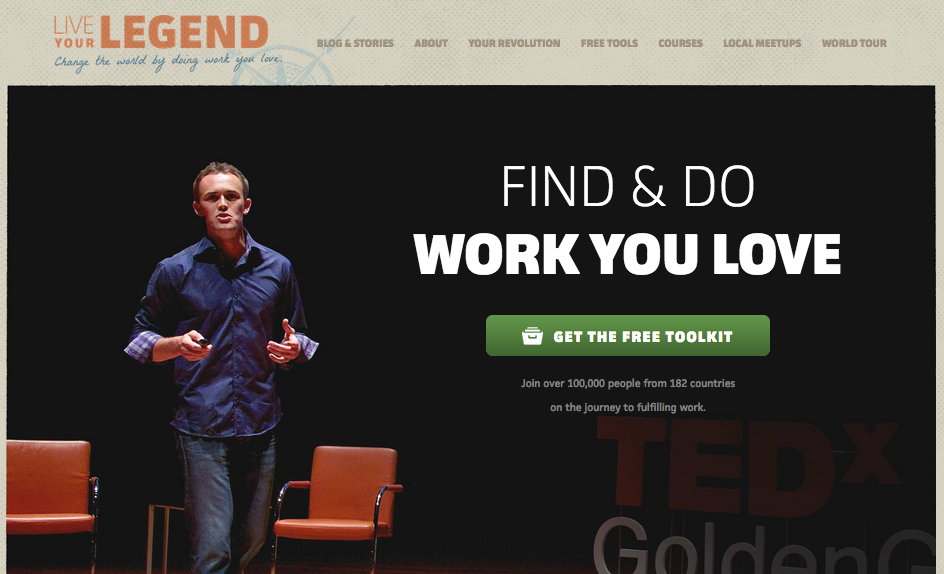
Scott Dinsmore of liveyourlegend.net coaches people to a) discover their passion and talents and b) make money with them.
On his site, he segments his content so that everyone can find the right articles on their way to their dream job.
In this way, he convinces people of his worth at every stage (from "I need to do something different with my life" to "I know what I want, but I don't know how to implement it").
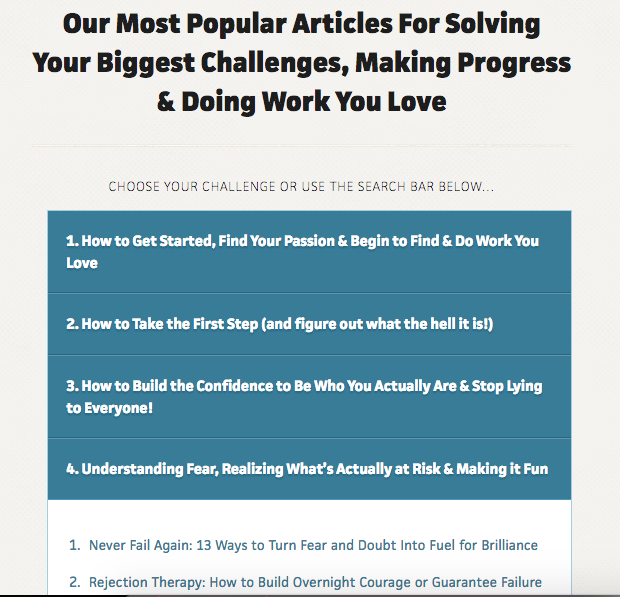
Once you read multiple articles on his website on a particular topic, you will immediately receive an e-book or whitepaper focused on that topic via email!
*This is also possible for your organization through Marketing Automation Software.
Have you ever thought about dividing your customers into segments? This could be anything:
If you haven't started customer segmentation yet, I recommend getting started with it.
(it may still get you more than you think).
The reason for doing this is that this way you can make your sales message very personal - each group of customers will then receive the right message with the right arguments, which will take them further to the sale.
Probably each customer segment of your company has different drivers and needs regarding your product.
Make sure you have these drives and needs clear!
'But.....how do I get these drives and needs clear on paper?'
Simple: ask your current customers.
They know perfectly well why they became customers - and what their initial doubts were.
Collect these and use it in your sales pitch, both offline and online.
Example segmentation (1)
Let's go back to the case of our wealth manager. It may choose to keep their emails, web copy, newsletters, etc. the same for all clients.
This way, all (potential) customers receive the same message......
Not good.
Of course, this can be much sharper when they customize their sales message by segment/target group (thereby personalizing the message).
For example, they may divide their customers as follows:
Segment 1: Invests his assets himself
Segment 2: Has his assets in a savings account
Segment 3: Invests with another asset manager
With this segmentation, the asset manager can write all of their further emails and articles very specifically - exactly to the needs of each segment.
After all, a customer who has his assets in a savings account needs a very different sales message than a customer who invests his assets himself!
Simple: you let people choose which group they belong in. Check out this email I received from an asset manager after I downloaded their white paper:
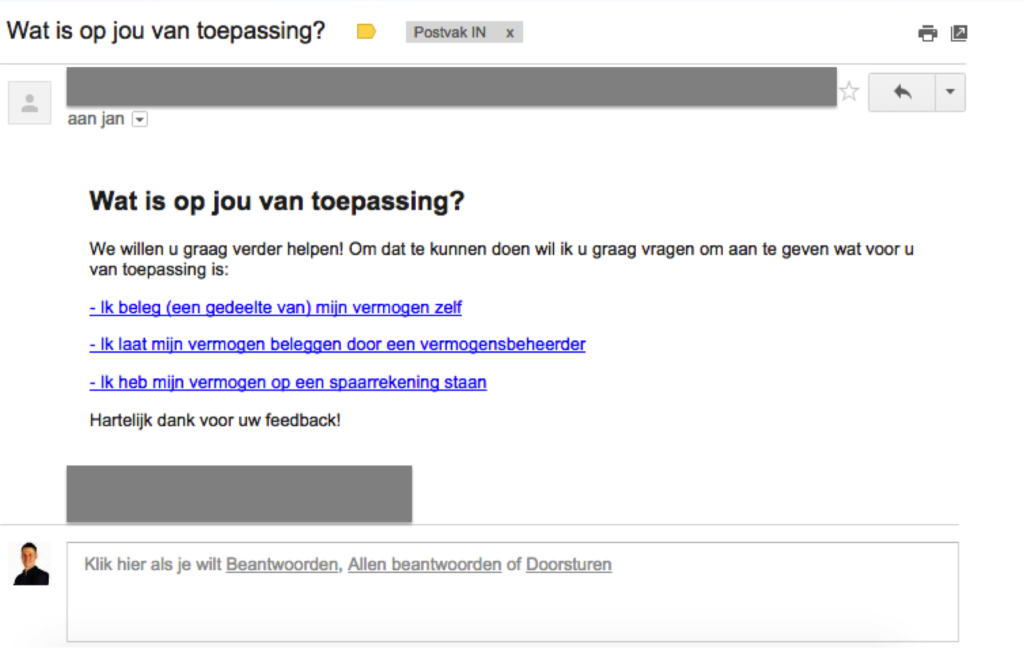
Not only do they thus segment their (potential) customers with a simple email, they then help these people move forward.
In fact, each link contained a valuable article precisely targeted to the target audience.
In summary, as soon as I click 1 of these links, I am automatically added to a specific email list. This way, this asset manager knows exactly what articles to send to their email lists.*
This is all carried out through Marketing Automation Software*.
*How might you implement this for your organization?
Sample segmentation (2)
We could do further segmentation.
Take the case of our marketing agency, Searchuser.co.uk. Here the situation is different again from that of the asset manager.
In fact, we offer clients multiple products, with each product fulfilling a different need (Lead Generation, Website Optimization, Marketing Automation).
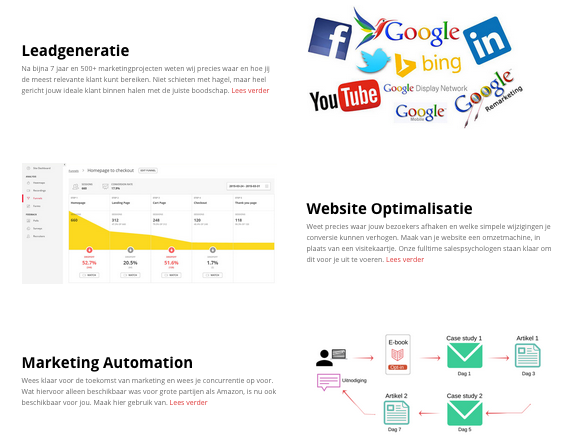 So for us it is important To segment at a needs level: what are customers currently struggling with and needing help with?
So for us it is important To segment at a needs level: what are customers currently struggling with and needing help with?
All in the field of online marketing, of course.
We segment our target groups by offering several free products (email course, consultation, e-book), all of which are linked to needs of the potential customer:
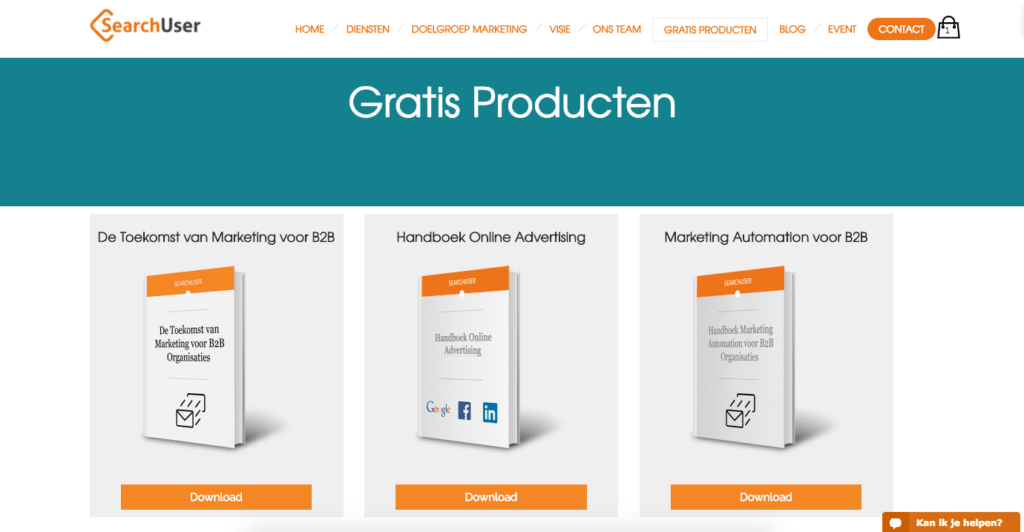
Once you download one of these free products, you automatically join an email list.
That's not all: you will also receive a link from us after the download, with questions.
This way (by asking what people want to learn) we can customize our articles and content at the individual level.
*To recap: this is possible with Marketing Automation Software
Summary:
Would you like to know how your sales message can create more customers? We'd love to help.
